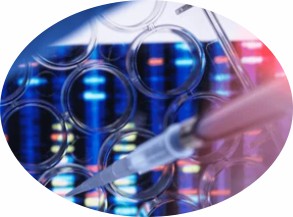Engineered Strain Screening, Modification and Optimization
Rapid development of biotechnology has led to the screening, modification, and optimization of engineered strains as the key to efficient biosynthesis. Engineered strains are genetically modified to produce target compounds under specific conditions. Lifeasible relies on advanced biosynthesis technology platforms to screen, modify, and optimize engineered strains to help further provide more sustainable solutions for agricultural production.
Application of Engineered Strain Screening, Modification and Optimization
- Biofuel production. Production of biofuels using engineered strains is one of the essential applications of agricultural biosynthesis. For example, by modifying Escherichia coli and yeast, plant feedstocks can be effectively converted into biofuels such as ethanol and butanol.
- Synthesis of pesticides and fertilizers. Engineered strains can also be used to synthesize biopesticides and fertilizers. For example, natural pesticide ingredients can be synthesized by genetically modified microorganisms, reducing the use of chemical pesticides.
- Production of food additives. Engineered strains can also produce a wide range of food additives such as flavors, colors, and preservatives.

Our Service for Engineered Strain Screening, Modification and Optimization
Screening of engineered strains
- High-throughput screening techniques. Hundreds to thousands of strains can be screened simultaneously using automated equipment and microplate technology. This approach dramatically improves screening efficiency and excels, especially in large-scale screening.
- Screening based on fluorescent signaling. By constructing a fluorescent reporter gene system, we can couple the expression of target genes with fluorescent signals, thus realizing rapid detection and screening of target products.
- Cell growth-based screening. The synthesis of certain target products may affect the growth characteristics of cells, and we can observe the growth of cells to screen for engineered strains with specific traits.
Modification of engineered strains
- CRISPR/Cas9 technology. This is a highly efficient gene editing tool capable of precisely inserting, deleting, or replacing specific DNA sequences in the genome. We utilize this technology to engineer strains for rapid gene targeting efficiently.
- Genomic recombination. Genomic recombination technology can achieve overall modification of the strain genome through recombinase-mediated reactions. This method is suitable for large-scale modification, especially when multiple genes need to be modified simultaneously.
- Metabolic engineering. Metabolic engineering is optimizing the synthesis of target products by modulating the metabolic pathways of microorganisms. By regulating key enzymes and reconfiguring metabolic pathways, we can help researchers significantly improve the synthesis efficiency of target products.
Optimization of engineering strains
- Optimization of culture conditions. The optimization of culture conditions has an essential impact on the performance of engineered strains, and we adjusted culture conditions such as temperature, pH, and nutrients to significantly improve the growth and metabolic activity of the strains.
- Metabolic flow analysis. Metabolic flow analysis helps identify bottleneck reactions and the direction of metabolic flow by quantitatively analyzing the metabolic pathways of microorganisms to target the optimization of engineered strains.
- Evolution of engineered strains. We can also use targeted evolution, which enables us to obtain engineered strains with better adaptability and higher product yields through repeated mutation and screening.
Highlights of Our Engineered Strain Screening, Modification and Optimization
- Expertise. Our technical team has expertise in many fields, including biology, chemistry, and other areas, and can provide comprehensive solutions.
- Rich experience. We have rich practical experience in developing and optimizing engineered strains, and can quickly respond to various challenges.
- Advanced technology. We use the latest gene editing technology and synthetic biology methods to ensure the efficiency and accuracy of our services.
- Customized solutions. We can provide customized screening and modification solutions for engineered strains according to the specific needs of our clients to ensure that their project requirements are met.
 Fig.2 Our service advantages. (Lifeasible)
Fig.2 Our service advantages. (Lifeasible)
Screening, modification, and optimization of engineered strains are of great significance and broad application prospects in agricultural biosynthesis. Lifeasible can construct engineered strains with high-efficiency production capacity and excellent stability through high-throughput screening technology, gene editing technology, and other technologies. If you are interested, please feel free to contact us.
For research or industrial raw materials, not for personal medical use!

 Fig.2 Our service advantages. (Lifeasible)
Fig.2 Our service advantages. (Lifeasible)